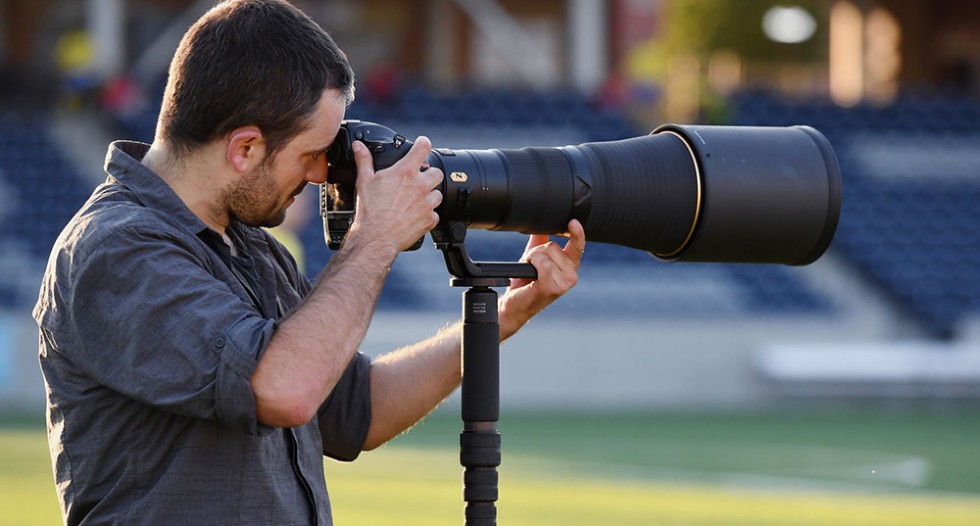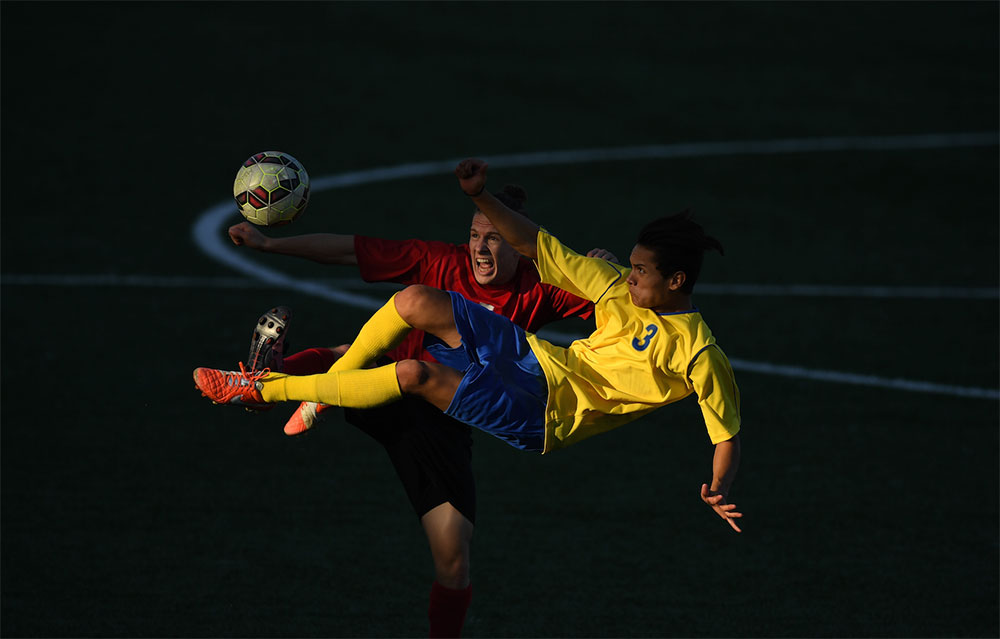First Impressions for the Nikon D5: Sports Photography with Matthias Hangst
For award-winning sports photographer Matthias Hangst, who constantly tracks fast moving subjects through a lens, the new Nikon D5 camera’s advances left a strong impression. “My personal dream for every camera: be a tool that gives me the freedom to concentrate on being creative and producing great images.” As a sports photographer, Hangst spends a lot of time at big tournaments and on numerous assignments. “There are times when we are on the road for weeks. We all know there will be that one moment not to be missed—that one frame of the game. The D5 will definitely help to catch that moment.”
Increasing the Chance of Capturing that Important Moment
Among the notable developments with the D5, Hangst finds the redesigned AF system—which now has 153 focus points, 99 cross-type sensors plus a dedicated processor—to be outstanding. The camera is equipped with a dedicated AF processor capable of rapid calculations.
This processor brings superior AF response that is primed to constantly assist a photographer while tracking using multiple focus points—such as when following a soccer ball being centered by one player and concurrently keeping focus on another player as he heads towards the ball. Additionally, a new AF algorithm efficiently coordinates a range of processing operations, including advanced subject detection and detailed scene analysis.
The algorithm enables precise AF tracking of moving subjects during 12 frames per second (approximate) continuous shooting. The superior AF performance during high speed continuous operation is refined even further when paired with the latest NIKKOR super telephoto lenses.
“Not only do I notice an across the board boost to AF performance, but also dramatic response improvement when working through challenging moves or low light situations. This camera will increase the chance of getting that one frame, that one shot,” he asserts. “AF is extremely fast and very accurate.” Hangst also calls out the camera’s extended ISO, plus its high rate of frame capture per second, to be significant upgrades.
A competitive athlete himself, Hangst has covered seven Olympic games and has worked for Deutsche Fussball Liga (DFL), Wimbledon and other top sporting organizations. During launch planning he toiled aside the Nikon creative team to develop imagery from soccer, water polo and gymnastics environments.
Of D5, Matthais says, “This camera will increase the chance of getting that one frame, that one shot, he asserts. AF is extremely fast and very accurate.”
Shutter Brilliance on a Soccer Field
The Nikon D5 captures at 12 fps continuous while experiencing full AF and AE performance, and up to 200 shots in a single burst. That’s a dream to a sports photographer.
While on the soccer field, Hangst toiled under overcast skies tinged by rain to produce a stack of images that, in his opinion, were ok but not “the shot.” Explaining, “Adapting is a big thing for a sports photographer. You have to deal with how conditions play out and try to get the best from each situation.” Fortunately, by late afternoon the sun started to appear and Hangst soon saw conditions start to emerge for “the shot.” Noting, “It’s the one moment; the moment where you get that beautiful glow,” referencing how late daylight streamed onto the players in slices, heightening a display of tricot jersey colors red and yellow over green grass. “The number one thing about photography is how quickly a photographer and a camera can react.”
His photograph above was created in Manual mode, ISO 400, shutter 1/4000. An aperture of f/4.5 was set with the AF-S NIKKOR 600mm f/4E FL ED VR. The Nikon D5 was dialed to Dynamic-area AF using 25 points to track erratically moving subjects.
“The number one thing about photography is how quickly a photographer and a camera can react.”
Balanced Perfection Poolside and Beyond
During each day of capture Hangst consistently acquired files that displayed balanced and neutral color. The D5 incorporates a highly refined 20.8 MP Nikon FX-format CMOS sensor. This sensor yields rich tonal gradations, plus a refined signal-to-noise ratio, both of which contribute to outstanding image quality at high ISO sensitivities. Courtesy of the EXPEED 5 image-processing engine, ultimate detail reproduction is rendered straight out of the camera when capturing high-quality JPEG pictures required by media outlets.
“Despite the varying locations and themes, color reproduction is faithful. Further, you witness a great balance from bright to dark areas.” Impressive to the photographer was also seeing how skin tones appeared within his poolside shots. Even with strong environmental influences, such as reflection, droplet spray and the cast from blue water, tones showed solid results with no issues.
For this tight close-up (above), Hangst affixed the AF-S NIKKOR 600mm f/4E FL ED VR on a monopod and dialed aperture to f/4.5. He set ISO to 400. “Aside from showcasing color accuracy, I wished to highlight the camera’s focal precision and AF reaction time by creating an image that utterly froze water droplets in midair. I could have worked at 1/2000, but I opted for a shutter speed of 1/4000 and once more set autofocus to Dynamic-area AF using 25 points. Working with a wide open aperture and 600mm lens, what results is a depth of field that is just centimeters. The incredible thing about this camera is its technical precision. The responsiveness of the AF beautifully throws emphasis just where I wish it to be.”
“The incredible thing about this camera is its technical precision. The responsiveness of the AF beautifully throws emphasis just where I wish it to be.”
Unparalleled Perfection in Low Light
For a third image (above), the team staged a dimly lit gymnastics venue with a black backdrop. Hangst’s technical objective was to showcase AF prowess when shooting at high ISO. “The D5 expertly locks in on constantly moving subjects and keeps them in sharp focus. The image showing a gymnast aside the parallel bars was selected for its grace and sharpness in very low light. It was captured using a fast shutter speed of 1/2500, ISO 6400, Dynamic-area AF with 25 points and an aperture of f/3.5. Choice of lens was the AF-S NIKKOR 200mm f/2G ED VR II.
“I am happy to confirm that the Nikon D5 gives me up to 1.3 stops of exposure improvement in high ISO performance (and that can change depending how an event is covered). With this boost I gain the possibility to work at faster shutter speeds. I also have the option to use longer glass, including the 600mm f/4E, as well as the AF-S NIKKOR 800mm f/5.6E FL ED VR, that I couldn’t previously when working in poor lighting environments.”
In Summary
“A photographer always has that perfect frame, that perfect moment in mind,” remarks Hangst. “The Nikon D5 gives me freedom to concentrate on the creative part of my job. I prefer to not spend a lot of time thinking about the mechanics and complications of capture; I prefer to focus on making my best images. The right technology does not require you to think about it; just use it.”
Hangst’s First Impressions for the Nikon D5:
-
With extended ISO I can freeze super fast action even when working in low light conditions.
-
I observe a 1 to 1.3 stop exposure improvement in high ISO performance. This opens the potential to work at faster shutter speeds and/or try lenses that I couldn’t use before when I was shooting in limited lighting settings.
-
The camera delivers balanced and correct color reproduction. Color is accurate and there is a smooth range from bright to dark areas.
-
The D5 will give me new views and moments to capture because I may now work with different glass.









